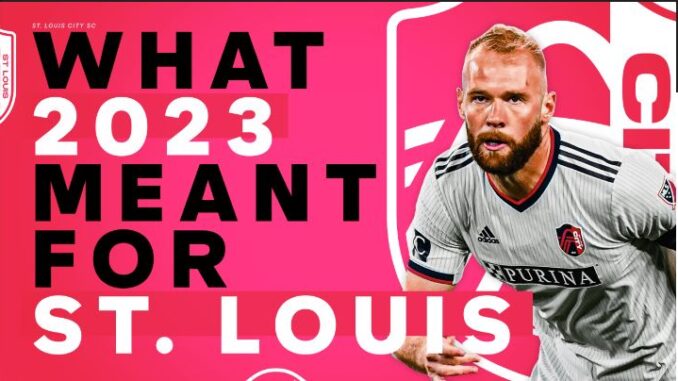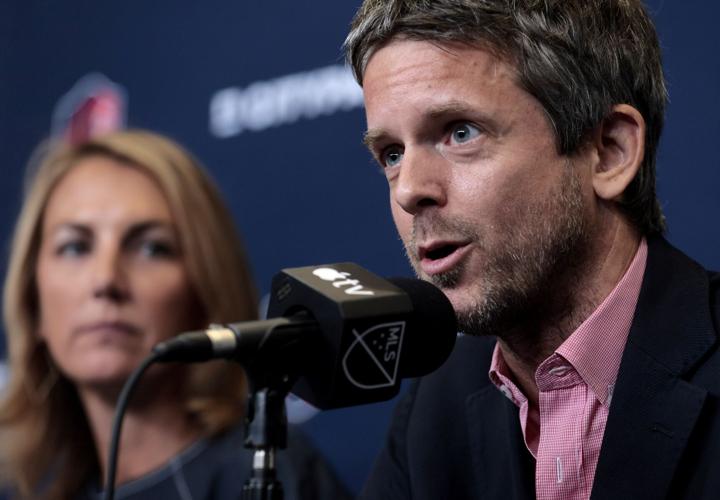
St. Louis is America’s soccer capital. The sport took root and flourished here from its inception. When the dark days arrived, it was one of the few places where the game not only survived, but thrived.
The demise of the old ASL 90 years ago had no effect on soccer in St. Louis. When the United States men’s national team qualified for the World Cup in 1950, it was full of St. Louis natives who’d played semi-pro for local factory teams and won the US Open Cup almost every year. Those players – those trailblazing winners, conquerors of England – would go on to coach the next generation of Americans from the heart of the country.

That generation built a college dynasty at St. Louis University, won Open Cups, and then became coaches, seeding the entire St. Louis area with institutional knowledge on “how to build a soccer player” that other places in the US and Canada couldn’t even dream of. Fathers and sons, mothers and daughters, all learning the game from the crib to college and beyond, generation after generation.
By the time MLS was founded, soccer had meant something (or, to some, everything) in St. Louis for nearly 100 years. Naturally, talk of locating a team in the Gateway City began almost immediately, but for various reasons (all of which boiled down to never having the right ownership group step in with the right plan at the right time), it kept getting pushed back.
Ten years have passed. Fifteen. David Beckham came and went, ushering in a new era for our league and our country.
After twenty years, would St. Louis ever be admitted? With the addition of academies, Targeted Allocation Money (TAM), and a third DP, MLS, as well as soccer-crazed markets like Seattle, Portland, Atlanta, and Orlando, had begun to hum. The city that never slept was still sending players to the league, Europe, and the national team, but the prospect of having their own team was always pushed back to the next few years, to the next round of expansion – or the one after that.
However, in September 2018, the St. Louis Post-Dispatch reported on meetings between MLS executives and Missouri state officials. Was the ball really in play here?
We received our answer a month later: Yes! A group of owners had formed, one with the necessary resources and a strong, generations-long local connection. They were St. Louis soccer fans who planned to bring soccer to the city.
The new stadium was unanimously approved by the town board in November 2018. The following spring, MLS announced that the league would not stop at 28 teams, but would expand to 30, and that St. Louis was one of two markets deep in talks with the league.
Four months later came the announcement that had been a century in the making: St. Louis was getting its team.
It was a long wait (COVID caused it to be a year longer), but it was all worth it in the end. Later in this column, I’ll pick at a few scabs – the tactics, the personnel, the underlying numbers waving bright red flags – but this year was, first and foremost, a celebration of this sport in this town. The fans, the generations of families who had passed the game down from generation to generation, never letting it fade or die, deserved to be celebrated. They deserved to be happy.
They nabbed it. MLS arrived in St. Louis, and St. Louis won. And the fans stood up and screamed, and then some more.
That is what the year 2023 meant for St. Louis CITY.

Tactics and Formation
CITY’s ownership group made it clear right away that they wanted to be tough, fast, and direct by hiring German executive Lutz Pfannenstiel – he of the Hoffenheim lineage – as sporting director. Pfannenstiel reinforced that identity by hiring Red Bull lineage Bradley Carnell as the team’s first head coach.
St. Louis, on the other hand, were tough and fast, vertical and direct. There was a lot of high pressing, but more often than not, St. Louis sat in a mid-block, setting up ambushes around the midfield stripe. Winning the ball there gave them more room to attack than if/when they won it higher.
As a result, they had the fastest direct speed in MLS by a mile (1.8 meters/second), the fewest passes per sequence, the shortest sequence time, and the highest percentage of passes played forward. When explaining the team’s halftime adjustments and subsequent second-half explosions, Carnell would frequently say things like “we had too much of the ball in the first half, we needed to pass less” in postgame interviews.
There was no truly set formation throughout this, as Carnell had this team play out of a 4-4-2 diamond, a 4-2-2-2 diamond, and a 4-2-3-1 diamond.
Highlight
Every single play from the first five games, especially the opener against Austin, could be replayed here. There was something magical in the air as this team made the best start in MLS expansion history.
You could also choose the first meeting with Sporting KC, their blue-clad neighbors to the west, in late May. St. Louis had cooled off considerably by that point; perhaps the bloom had faded a little?
Nope. They slammed the brakes on their well-established neighbors, sending them back to the Kansas cornfields on the strength of a 4-0 victory.
But I’m going with the other regular-season victory over Sporting as the season’s high point:
St. Louis did not play particularly well in this game. But Allstate MLS Goalkeeper of the Year Roman Bürki delivered a time capsule performance, DP center forward Joo Klauss scored a time capsule goal, and Carnell did his line-change-at-the-hour-mark mass substitution thing that has won this team so many games this year.
And just like that, what had been a tight, scoreless game for the first 70 minutes became a laugher in the final 20. It finished 4-1, a victory built on the team’s strengths.
CITY became the first expansion team to win a regular-season conference title with the victory. Even the old Chicago Fire had not accomplished this feat.
The audience went insane.
Lowlight
They wouldn’t win another game the rest of the way, falling in their final two regular-season matches to finish just short of an expansion team’s single-season points record (they had 56; LAFC reached 57 in 2018).
Things got worse when Sporting came calling in the playoffs. My line was, “This is the type of series we’ll be talking about in 30 years,” and I guarantee Sporting fans will do just that. They completely dominated the hosts, forcing them to carry possession, winning every second ball, and hammering home one golazo after another in a 4-1 win to start the Best-of-3 series.
Four days later, they’d wrap it up with a 2-1 home win that never felt close.
Revelation
All four players, Nicholas Gioacchini, Aziel Jackson, Indiana Vassilev, and Sam Adeniran, have a case, but none has emerged to the point where I’m certain we’ll see the same level of productivity next year.There are some warning signs, particularly with this team’s finish.
Disappointment
There were also some red flags with the quality of chances given up by this team. Bürki stopped bailing out the defense so frequently once he got off his heater, and once that happened… well, 8W-12L-4D over the final five months of the year across all competitions paints a fairly accurate picture.
If I had to pick one thing, it would be Joakim Nilsson’s performance at center back. The 29-year-old Bundesliga veteran was supposed to be a foundational piece, but he was injured for much of the year and never looked up to speed when he returned. In his seven starts, St. Louis only won one.

Five Players to Build Around in 2024
Bürki (GK): He’s still one of the better goalkeepers in MLS, even if he’s not as good as he was in the first half of the season.
Klauss (FW): If he stays healthy, he should be able to score at least 15 goals. And he was the only one who showed up for the playoff series against Sporting.
Eduard Löwen (CM): Productivity dropped after a mid-year injury, but his class shines through.
CB Tim Parker: After a couple of bad seasons in Houston, he had a good year.
Jackson (AM): Has a plethora of tools and can be a lightning-fast chance creator at times. Then he’ll vanish. Has to find a way to be consistent.
Priority for the offseason
Fullbacks, and possibly another center back, depending on what they think of Nilsson (they must be honest here).
Another honest personnel assessment they must make is of d-mid Njabulo Blom, who was excellent in the first third of the season but deteriorated throughout the season. This is agonizing ball-watching in a must-win situation: the goal this offseason has to be to give Bürki less work in 2024.
Keep in mind that CITY has a DP slot open, so they can spend big on a new 6 or CB if the need arises.
Leave a Reply